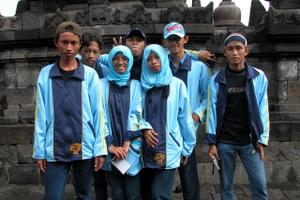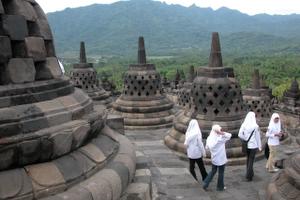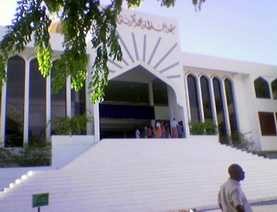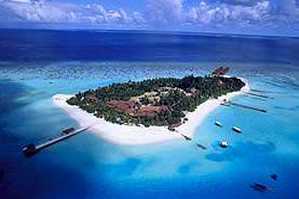Did you know that Nepal is home to a quarter of South Asia’s rhino population. The latest count of the population has shown that rhino numbers have dropped to less than 400 from nearly 600 animals in three parks in 2000 due mainly to poaching blamed largely on inadequate security caused by the long-running Maoist insurgency. Trading in the horn of the rhino is internationally banned, but experts say that poachers are encouraged by the big profit margin.
All posts by The Beetle
Country Statistics: Lowest Population Density
Want to get away and escape the crowds?
LOWEST POPULATION DENSITY2 (per sq mi): 2004
- Western Sahara – 2.6
- Mongolia – 4.6
- Namibia – 6.1
- Australia – 6.7
- Botswana – 6.7
- Suriname – 6.9
- Iceland – 7.4
- Mauritania – 7.5
- Libya – 8.3
- Canada – 8.4
Source: http://www.infoplease.com/ipa/A0762380.html
The Borobodur, Indonesia
Last December, the Beetle visited Indonesia. Apart from diving I took a trip to Java from Sulawesi and saw the Borobodur Temple (amongst other things). I stayed a few days in Yogyakarta, a name I shall forever have problems pronouncing and hired a car and driver for US 30 for the day which seemed a pretty efficient way of getting around. Much to the initial annoyance of my driver, we gave lifts to anyone (especially older people) carrying huge bundles and had the freedom to stop wherever I fancied and see out of the way things, and some really were out of the way! Mr Azim, my very patient driver looked after me well, as well as driving like he was trying to break the world land speed record and he made Yogyakarta to the Borobodur in just 40 minutes! Using public transport, it is possible to go by bus or minibus from Yogyakarta to the town of Muntilan, change at the terminal here to another bus for Borobudur. Note that the bus station at Borobudur is 1km away from the temple though it is possible to walk. Alternatively, you can go on one of many guided tours on mini buses to Yogyakarta.
It seemed to be the time of year when schools make their annual school trip outings. There must have been several hundred school children, lounging around, larking about, and taking lots and lots of photos! I found out, by talking with many of the groups that they came mainly from Sumatra and other parts of Java and they were absolutely delightful, as curious about me as I was about them. I got many tips on places to go on my travels and invites to family homes, which was very kind.
This was just one day after the horrific tsunami and there was a muted respect and appreciation for the events that were just starting to unfold, but at the same time, it was a holiday and the school children were having a whale of a time.
The Beetle was pretty much the only non Indonesian visitor on that day and the school children's main task seem to be to detract me from seeing the Borobodur at all, but I didn't mind. It was a lot of fun lining up, arms round the girls' shoulders, smiling broadly for the multitude of cameras that were bought out, just one more, just one more they'd say. And the boys, shyly jostling to see who could stand closest and arms held just above my shoulders, thinking I would not see them or feel them as long as they were not resting on me. They were funny adolescent youngsters. And then there was the name and signature signing in their little notebooks. I thought the whole thing was most odd, but a wonderful way to meet Indonesian people and my entire 4 hours spent there consisted of photo posing, though I got my own back and asked other people to pose for me, notebook signing and having simple English conversations. It was a lot of fun, though I kind of wished I'd had a little more of a chance to see a bit more of the Borobodur!

Ok, about the Borobodur: It is thought to have been built between
the end of the seventh and beginning of the eighth century A.D. For
about a century and a half it was the spiritual centre of Buddhism
in Java and then it was lost until its rediscovery in the
eighteenth century. The temples are set in beautifully manicured
gardens and are said to be composed of 55,000 square meters of
lava-rock is erected on a hill in the form of a stepped-pyramid of
six rectangular storeys, three circular terraces and a central
stupa forming the summit. The whole structure is in the form of a
lotus, the sacred flower of Buddha. For each direction there are
ninety-two Dhyani Buddha statues and 1,460 relief scenes. The
lowest level has 160 reliefs depicting cause and effect; the middle
level contains various stories of the Buddha's life from the
Jataka Tales; the highest level has no reliefs or decorations
whatsoever but has a balcony, square in shape with round walls: a
circle without beginning or end. Here is the place of the
ninety-two Vajrasattvas or Dhyani Buddhas tucked into small stupas.
Each of these statues has a mudra (hand gesture) indicating one of
the five directions: east, with the mudra of calling the earth to
witness; south, with the hand position of blessing; west, with the
gesture of meditation; north, the mudra of fearlessness; and the
centre with the gesture of teaching.

You are supposed to wander around the galleries and terraces always turning to the left and keeping the main structure to the right but I noticed that none of the school children observed this tradition. In total, Borobodur represents the ten levels of a Bodhisattva's life which he or she must develop to become a Buddha or an awakened one.
 Early morning is the best time to visit Javanese temples, Borobudur
included. The gate opens at 6 am, around sunrise. The view of the
surrounding volcanoes and the Bukit Menoreh range to the south is
clearest at dawn, although morning mists sometimes obscure the view
until 8 am. Visitors must walk 500 meters to the base of the hill
then climb a series of steps to reach the temple foot. To see all
the reliefs one must walk more than 2 km (1.25 mile) around the four
galleries and climb several flights of steps. The minimum amount of
time needed at the Site is 1.5 hours.
Early morning is the best time to visit Javanese temples, Borobudur
included. The gate opens at 6 am, around sunrise. The view of the
surrounding volcanoes and the Bukit Menoreh range to the south is
clearest at dawn, although morning mists sometimes obscure the view
until 8 am. Visitors must walk 500 meters to the base of the hill
then climb a series of steps to reach the temple foot. To see all
the reliefs one must walk more than 2 km (1.25 mile) around the four
galleries and climb several flights of steps. The minimum amount of
time needed at the Site is 1.5 hours.
All in all, it was a highly enjoyable day out and I thoroughly recommend it.
Country Statistics: smallest counties in the world
Country Statistics
| Smallest Countries (in sq mile): 2002 | ||
| 1. | Vatican City | 0.2 |
| 2. | Monaco | 0.8 |
| 3. | Nauru | 8.1 |
| 4. | Tuvalu | 10.0 |
| 5. | San Marino | 23.6 |
| 6. | Liechtenstein | 62.0 |
| 7. | Marshall Islands | 70.0 |
| 8. | St. Kitts & Nevis | 101.0 |
| 9. | Maldives | 116.0 |
| 10. | Malta | 122.0 |
Source: http://www.infoplease.com/ipa/A0762380.html
Gambling in Singapore
Singapore’s Prime Minister Lee Hsien Loong announced that the government had decided to give the go-ahead for two casinos on Marina Bay and on Sentosa resort island. Despite 30,000 people signing a petition against the idea, Mr Lee said the casinos were necessary to help Singapore attract more tourists. The casinos, which will be operational by 2009, are central to Singapore’s goal of doubling the number of tourists to 17 million a year. A casino is believed to help Singapore recover much of the $180m a year it is estimated that Singaporeans spend each year in neighbouring Malaysian casinos.
Being Careful: Thailand
This is the latest advice from the UK’s Foreign and Commonwealth Office on Thailand: there is a high threat from terrorism throughout Thailand, particularly in the far southern provinces of Pattani, Yala, Narathiwat and Songkhla. We recommend against all but essential travel to these four provinces where, since January 2004, there have been regular attacks including bombings and shootings. On 3 April, three bombs exploded in Songkhla Province, one at Hat Yai International Airport, one at a hotel and one in a shopping centre. Further attacks against places frequented by foreigners, including tourist resorts, could occur at any time.
Watch out for crimes of opportunity. Theft of passports and credit cards is a problem. Passport fraud is high and penalties are severe.
Penalties for possession, distribution or manufacture of drugs are severe and can include the death penalty.
There has been an increase since January 2005 in the number of reported cases of Dengue Fever, in particular in Southern Thailand and the area near the border with Malaysia. In a very small number of cases, Dengue Fever can be fatal if left untreated. If you suffer from a fever whilst (or shortly after) visiting Thailand, you should consult a doctor.
Exploding Toads
Thousands of toads in an area of northern Germany are exploding. Seriously, this is not a late April Fool’s joke. Scientists do not yet know why the toads are exploding, but they are contracting some type of disease that causes their body to expand to three and a half times their normal body size – to bursting point. The BBC news report that the toads’ entrails are being propelled up to a metre (3.2ft), in scenes that have been likened to science fiction.
Answers to Flag Quiz
Answers to Flag Quiz

|

|

|

|

|
| Algeria | Botswana | Cayman Islands | Dominican Republic | Guam |
|---|
Our Friends Ryanair
Back in September last year, you may recall us reporting that Ryanair were proposing to make in-flight entertainment available on its flights. Passengers were to be charged £5 ($9.48) to access films, cartoons and tv shows on portable lap top type units. Ryanair Chief Executive Michael O'Leary who said in September the units would become “as common as the in-flight magazine”. These have been on trial since November and are about to be abandoned. “It was lack of demand. They decided not to follow it any further,” a Ryanair spokeswoman said. Ryanair said it had not lost any money on the system, which was on trial in only five planes before making a significant investment. The latest money making wheeze is to have in-flight gambling. Watch this space!
News comes of Ryanair selling a brand of water called Blue Rock water, which costs £1.85 for a 500 ml. Reports state that this special Ryanair water isn't from a pure mountain stream or highland spring – it is just carbonated tap water. To purchase the same water from Thames Water i.e. turn on the tap costs 0.06p per litre. The only difference between turning on the tap in any London home and Ryanair's Blue Rock is that the sparkling version has been carbonated at a water treatment works in Beckton, East London, before being bottled and labelled. While the label does not claim to be genuine spring water, neither does it make it clear that it is tap water. Britvic, which 'makes' Blue Rock, made exclusively for Ryanair, claimed the brand was about to be replaced by a new product called Pennine Spring, sourced from a natural spring in Huddersfield.
The Maldives Tourist Info by Muaz Adnan
Scattered across the equator across the Indian Ocean, the pearl like islands of the Maldives depicts the rare vision of a tropical paradise. Palm fringed islands with sparkling white beaches. Turquoise lagoons, clear warm waters and corals reefs teeming with abundant varieties of marine fauna and flora, continue to fascinate visitors as it has fascinated other in past, for thousand of years. Marco Polo referred to the Maldives as the flower of the Indies and Ibn Batuta referred to the Maldives as one of the wonders of the world.
Truly a natural wonder, the height of the islands rarely reach above two metres. The 1,192 islands consist of 27 atoll formations, spread over 90,000 square kilometres. The Maldive atolls are a classic discovery in their own right: the word atoll is derived from Dhivehi, the Maldivian language, from the word atholhu.
The islands are surrounded by shallow crystal clear lagoon enclosed by coral reefs. The unique islands provide visitors with one of the most breath taking views of underwater life in the world. Formed above peaks emerging from the depths of the ocean, upon layers of both living and dead coral, and remnant of other marine life, the islands are generally covered with dense tropical vegetation. Coconut palms towering above dense shrubs and hardly plants protecting the shores from erosion are natural features in most islands. These islands together embody living entities in various stage of formation. As interdependent elements in ecology, in a food chain where birds, fish and other marine life co-exist, with humans at its apex as caretakers for centuries.
Measuring 820 kilometres north to south and 120 kilometres east to west at its greatest width, the closest neighbours are India and Sri Lanka. With a population 270,110 ( 2000 official estimate), only 199 islands are inhabited 87 islands are set aside exclusively for tourist resort development.
There are plenty of things to do in the Maldives. You can take a diving safari where you can visit inhabited islands (fishing villages), resorts and uninhabited islands. Even if you are not a diver, or a honeymooner, there are cultural shows, excursions to Malé, night fishing, barbecues (subject to weather and length of stay) to keep you entertained. It is possible to visit a local inhabited island and see their simple life style in harmony with nature also you will get the opportunity to see some of the typical daily chores carried by the simple island forks while other maybe involved in building a wooden local dhoni boat or weaving rope etc.

Sultan Mosque

A typical resort, this one is the Laguna Beach Resort
Some people like the big game fishing and night fishing where you can usually go to an uninhabited island to have a barbecue after the fishing.
If you are interested in visiting the Maldives, Mr Muaz Adnan would be only too happy to advise you and make any travel arrangements and bookings for you. He can be contacted by e-mail on: muazadnan2002@yahoo.com
